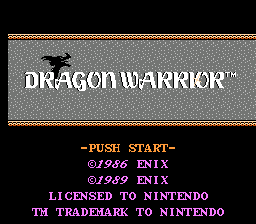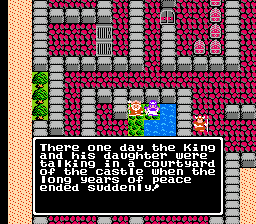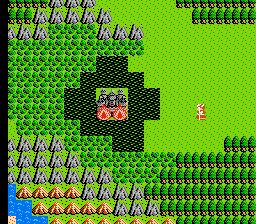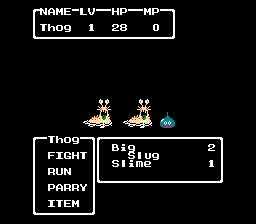BONUS: Where It All Started
I believe that I have already made clear how brutal this game's difficulty can be. So far, we haven't gotten a whole lot of money from the handful of quests that we've done so far, and what little we've earned is going to replenishing our supplies. That's today's economy for you, am I right?
The creator has gone on record as claiming that the game's premise was inspired by Takeshi's Challenge, a game produced by Japanese comedian and filmmaker Beat Takeshi, intended to irritate the player by requiring them to take some of the most unintuitive actions available to progress. And trust me, that game gets really out there. While this may be the case, I believe that the game's design choices perfectly emulate the experience of some of the first RPGs that I've played.

Dragon Quest is a game series that needs no introduction. Not only is the first game in this series among the first JRPGs ever made, but it also codified a lot of the gameplay elements used in RPGs to this day. Furthermore, it was one of the first games that I ever played when I discovered browser emulation in the late 2000s.

While I knew that this game was a seminal RPG, my first impression of it was less than promising. After entering your name, you're given your mission right at the start--slay the evil Dragonlord who lives in the castle right across the river from where you start. Unfortunately, nobody in the kingdom knows how to build a boat, so you're forced to figure out how to get there on your own. Fortunately, the king offers you the treasures from his throne room to help you...which consist of 120 gold, a torch and the key the opens the door outside. Gee thanks.

Having to choose between buying the second-weakest weapon and the second-weakest armor in the first town was truly a formative experience for me. The next one came when I stepped outside into the wilderness.

One of the many gameplay elements that it codified was its turn-based, menu-based combat system. Hell, whenever someone thinks of an RPG, a combat menu like this will probably be among the first things to come to mind.
I don't think I need to tell how what each of the available commands works, so I'll just get right to the point. Over the course of this game, you will be expected to go though hundreds, if not thousands, of these turn-based bouts in order to build up funds and experience points. But nothing can compare to the thrill of hearing that iconic level-up jingle, filling you with the hope that you can make it further from the starting castle, reach the depths of that dungeon hiding a key item, or slay the dragon holding the princess captive, or that the new spell you earned will turn the tide of the upcoming battles
...At least, until you get whacked by a too-strong-for-your-level encounter, and booted right back to the starting castle with half your gold. Well, so much for getting that one piece of equipment you had your eye on.
Even though I recognized its importance to gaming history even at the time, it wasn't this game, but its sequel, that I spent a significant amount of time playing through this emulator.


The story of this game involves two princess and a princess, who are established as being the descendants of the protagonist from the first game. It opens with a scene that's suprisingly lengthy for an NES game, in which the princess' castle is attacked by monsters and burned to the ground. It's up to you, the prince of Midenhall, to slay the evil wizard responsible.

Right from the start, you can already see its vast improvents over its predecessor. Aside from the intro adding a more personal motivation for the hero, the graphics are more polished, and the menus are slightly more streamlined--no more do you have to select the Stairs command to go up or down stairs. But the biggest improvement comes right when you step outside.

You can face more than one enemy at once. This may seem quaint now after playing more modern RPGs, but back then, it added an entirely new layer of strategy to the game.
This also applies to your party as well. In the first few hours, you end up recruiting the prince and princess of the neighboring kingdoms, including the one whose castle got demolished. Both of them are spellcasters to contrast the hero's physical prowess, and their skills single-handedly deepen the strategic options available to you, with effects ranging from healing to area attacks to buffing to status effects.
Of course, the series' infamous difficulty is still present here. After bringing the party together, and gaining access to a boat, it isn't clear at all where to go next, or what you're meant to do in order to bring the fight to the evil wizard. You end up going all across the game map, braving these maze-like dungeons to pick up the key items needed to reach the wizard's castle. But through perseverance (and a guide) I eventually managed to reach the endgame--that, for some reason, has giant apes that blow themselves up to kill your party, so I never actually managed to finish the game--at least, up until I played the mobile version not too long ago.
While I'm aware that the creator of I Hate You, Please Suffer is a big RPG fan, I'm not sure if they've ever played any of the Dragon Quest games. Even so, I could easily recognize Dragon Quest's DNA in this game, with a more modern-day twist. But then again, you can see Dragon Quest's DNA in practically every RPG Maker game. It's built into the engine, after all.